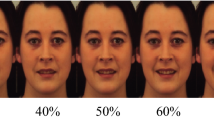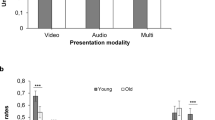Abstract
Age-related deficits are often observed in emotion categorization tasks that include negative emotional expressions like anger, fear, and sadness. Stimulus characteristics such as facial cue salience and gaze direction can facilitate or hinder facial emotion perception. Using two emotion discrimination tasks, the current study investigated how older and younger adults categorize emotion in faces with varying facial cue similarity and with direct or averted gaze (Task 1) and in faces that appear on actors in congruent or incongruent contexts (Task 2). When context was included, the target’s gaze direction was averted toward emotionally laden objects in the background context on half of the trials. In both tasks, younger adults generally outperformed older adults. Discrimination performance was best when cue similarity was minimal. Negative facial emotion cues were interpreted through the lens of the context in which they appear, as facial emotion judgments in both age groups were impacted by background contextual emotion cues, especially when highly confusable negative emotions were evaluated. Although the contextual emotion cues were deemed irrelevant within task instructions, these cues were nevertheless integrated into one's percept. When emotion discrimination proved difficult, older adults were more inclined than younger adults to use the additional context to support their decision, suggesting that context plays a pivotal role in older adults’ everyday evaluation of emotion in social partners.




Similar content being viewed by others
Availability of Data and Material
Data and material can be found on Open Science Framework (OSF): https://osf.io/th8zx/?view_only=e667f09325874047b1be401889b435d0.
Code Availability
Availability of stimuli and E-prime 2.0 experiment code available by request to corresponding author.
References
Adams, R. B., & Kleck, R. E. (2005). Effects of direct and averted gaze on the perception of facially communicated emotion. Emotion, 5, 3–11. https://doi.org/10.1037/1528-3542.5.1.3
Aviezer, H., Dudarev, V., Bentin, S., & Hassin, R. R. (2011). The automaticity of emotional face-context integration. Emotion, 11, 1406–1414. https://doi.org/10.1037/a0023578
Aviezer, H., Hassin, R. R., Ryan, J., Grady, C., Susskind, J., Anderson, A., Moscovitch, M., & Bentin, S. (2008). Angry, disgusted, or afraid?: Studies on the malleability of emotion perception. Psychological Science, 19, 724–732. https://doi.org/10.1111/j.1467-9280.2008.02148.x
Barrett, L. F., Adolphs, R., Marsella, S., Martinez, A. M., & Pollak, S. D. (2019). Emotional expressions reconsidered: Challenges to inferring emotion from human facial movements. Psychological Science in the Public Interest, 20(1), 1–68. https://doi.org/10.1177/1529100619832930
Barrett, L. F., & Kensinger, E. A. (2010). Context is routinely encoded during emotion perception. Psychological Science, 21, 595–599. https://doi.org/10.1177/095679761036357
Beaudry, O., Roy-Charland, A., Perron, M., Cormier, I., & Tapp, R. (2014). Featural processing in recognition of emotional facial expressions. Cognition and Emotion, 28, 416–432. https://doi.org/10.1080/02699931.2013.833500
Becker, D. V., Kenrick, D. T., Neuberg, S. L., Blackwell, K. C., & Smith, D. M. (2007). The confounded nature of angry men and happy women. Journal of Personality and Social Psychology, 92, 179–190. https://doi.org/10.1037/0022-3514.92.2.179
Bijlstra, G., Holland, R. W., & Wigboldus, D. H. J. (2010). The social face of emotion recognition: Evaluations versus stereotypes. Journal of Experimental Social Psychology, 46, 657–663. https://doi.org/10.1016/j.jesp.2010.03.006
Blanchard-Fields, F. (2007). Everyday problem solving and emotion: An adult developmental perspective. Currently Directions in Psychological Science, 16, 26–31. https://doi.org/10.1111/j.1467-8721.2007.00469.x
Calvo, M. G., & Nummenmaa, L. (2008). Detection of emotional faces: Salient physical features guide effective visual search. Journal of Experimental Psychology: General, 137, 471–494. https://doi.org/10.1037/a0012771
Carstensen, L. L., & Mikels, J. A. (2005). At the intersection of emotion and cognition: Aging and the positivity effect. Current Directions in Psychological Science, 14, 117–121. https://doi.org/10.1111/j.0963-7214.2005.00348.x
Chaby, L., Hupont, I., Avril, M., Luherne-du Boullay, V., & Chetouani, M. (2017). Gaze behavior consistency among older and younger adults when looking at emotional faces. Frontiers in Psychology, 8, 1–14. https://doi.org/10.3389/fpsyg.2017.00548
Charles, S. T., & Campos, B. (2011). Age-related changes in emotion recognition: How, why, and how much of a problem? Journal of Nonverbal Behavior, 35, 287–295. https://doi.org/10.1007/s10919-011-0117-2
Craig, B. M., & Lipp, O. V. (2018). The influence of multiple social categories on emotion perception. Journal of Experimental Social Psychology, 75, 27–35. https://doi.org/10.1016/j.jesp.2017.11.002
Ekstrom, R. B., French, J. W., Harman, H. H., & Dermen, D. (1976). Kit of factor-referenced cognitive tests (Rev). Education Testing Services.
Faul, F., Erdfelder, E., Lang, A.-G., & Buchner, A. (2007). G*Power 3: A flexible statistical power analysis program for the social, behavioral, and biomedical sciences. Behavior Research Methods, 39, 175–191.
Folstein, M. F., Folstein, S. E., & McHugh, P. R. (1975). Mini-mental state: A practical method for grading the cognitive state of patients for the clinician. Journal of Psychiatric Research, 12, 189–198. https://doi.org/10.1016/0022-3956(75)90026-6
Fölster, M., Hess, U., & Werheid, K. (2014). Facial age affects emotional expression decoding. Frontiers in Psychology, 5(30), 1–13. https://doi.org/10.3389/fpsyg.2014.00030
Foul, Y. A., Eitan, R., & Aviezer, H. (2018). Perceiving emotionally incongruent cues from faces and bodies: Older adults get the whole picture. Psychology and Aging, 33, 660–666. https://doi.org/10.1037/pag0000255
Franklin, R. G., & Zebrowitz, L. A. (2016). Aging-related changes in decoding negative complex mental states from faces. Experimental Aging Research, 42, 471–478. https://doi.org/10.1080/0361073X.2016.1224667
Halberstadt, A. G., Cooke, A. N., Garner, P. W., Hughes, S. A., Oertwig, D., & Neupert, S. D. (2020). Racialized emotion recognition accuracy and anger bias of children’s faces. Emotion. https://doi.org/10.1037/emo0000756 Advance Online Publication.
Hayes, G. S., McLennan, S. N., Henry, J. D., Philips, L. H., Terrett, G., Rendell, P. G., Pelly, R. M., & Labuschagne, I. (2020). Task characteristics influence facial emotion recognition age-effects: A meta-analytic review. Psychology and Aging, 35, 295–315. https://doi.org/10.1037/pag0000441
Hess, U., Adams, R. B., Grammer, K., & Kleck, R. E. (2009). Face gender and emotion expression: Are angry women more likely men? Journal of Vision, 9(12), 1–8. https://doi.org/10.1167/9.12.19
Holland, C. A. C., Ebner, N. C., Lin, T., & Samanez-Larkin, G. R. (2019). Emotion identification across adulthood using the Dynamic FACES database of emotional expressions in younger, middle aged, and older adults. Cognition and Emotion, 33, 245–257. https://doi.org/10.1080/02699931.2018.1445981
Hugenberg, K. (2005). Social categorization and the perception of facial affect: Target race moderates the response latency advantage for happy faces. Emotion, 5(3), 267–276. https://doi.org/10.1037/1528-3542.5.3.267
Isaacowitz, D. M., Löckenhoff, C. E., Lane, R. D., Wright, R., Sechrest, L., Riedel, R., & Costa, P. T. (2007). Age differences in recognition of emotion in lexical stimuli and facial expressions. Psychology and Aging, 22, 147–159. https://doi.org/10.1037/0882-7974.22.1.147
Isaacowitz, D. M., & Stanley, J. T. (2011). Bringing an ecological perspective to the study of aging and recognition of emotional facial expressions: Past, current, and future methods. Journal of Nonverbal Behavior, 35, 261–278. https://doi.org/10.1007/s10919-011-0113-6
Katsikitis, M. (1997). The classification of facial expressions of emotions: A multidimensional-scaling approach. Perception, 25, 613–626. https://doi.org/10.1068/p260613
Macmillan, N. A., & Creelman, C. D. (2005). Detection theory (2nd ed.). Lawrence Erlbaum.
Malatesta, C. Z., Izard, C. E., Culver, C., & Nicolich, M. (1987). Emotion communication skills in young, middle-aged, and older women. Psychology and Aging, 2, 193–203. https://doi.org/10.1037//0882-7974.2.2193
Meeren, H. K. M., van Heijnsbergen, C. R. J., & de Gelder, B. (2005). Rapid perceptual integration of facial expression and emotional body language. Proceedings of the National Academy of Sciences of the United States of America, 102, 16518–16523. https://doi.org/10.1073/pnas.0507650102
Mienaltowski, A., Johnson, E. R., Wittman, R., Wilson, A., Sturycz, C., & Norman, J. F. (2013). The visual discrimination of negative facial expressions by younger and older adults. Vision Research, 81, 12–17. https://doi.org/10.1016/j.vsres.2013.01.006
Mienaltowski, A., Lemerise, E. A., Greer, K., & Burke, L. (2019). Age-related differences in emotion matching are limited to low intensity expressions. Aging, Neuropsychology, and Cognition. https://doi.org/10.1080/13825585.2018.1441363
Murphy, N. A., & Isaacowtiz, D. M. (2010). Age effects and gaze patterns in recognizing emotional expressions: An in-depth look at gaze measures and covariates. Cognition and Emotion, 24, 436–452. https://doi.org/10.1080/02699930802664632
Ngo, N., & Isaacowitz, D. M. (2015). Use of context in emotion perception: The role of top-down control, cue type, and perceiver’s age. Emotion, 15, 292–302. https://doi.org/10.1037/emo0000062
Noh, S. R., & Isaacowitz, D. M. (2013). Emotional faces in context: Age differences in recognition accuracy and scanning patterns. Emotion, 13, 238–249. https://doi.org/10.1037/a0030234
Orgeta, V. (2010). Effects of age and task difficulty on recognition of facial affect. The Journals of Gerontology, Series b: Psychological Sciences and Social Sciences, 65, 323–327. https://doi.org/10.1093/geronb/gbq007
Orgeta, V., & Phillips, L. H. (2008). Effects of age and emotional intensity on the recognition of facial emotion. Experimental Aging Research, 34, 63–79. https://doi.org/10.1080/0361073070162047
Radloff, L. S. (1977). The CES-D Scale: A self-report depression scale for research in the general population. Applied Psychological Measurement, 1, 385–401. https://doi.org/10.1177/014662167700100306
Reschke, P. J., Walle, E. A., Knothe, J. M., & Lopez, L. D. (2019). The influence of context on distinct facial expressions of disgust. Emotion, 19, 365–370. https://doi.org/10.1037/emo0000445
Roberts, S. O., Bareket-Shavit, C., Dollins, F. A., Goldie, P. D., & Mortenson, E. (2020). Racial inequality in psychological research: Trends of the past and recommendations for the future. Perspectives on Psychological Science. https://doi.org/10.1177/1745691620927709
Ruffman, T., Henry, J. D., Livingstone, V., & Phillips, L. H. (2008). A meta-analytic review of emotion recognition and aging: Implications for neuropsychological models of aging. Neuroscience and Biobehavioral Review, 1023, 1–20. https://doi.org/10.1016/j.neubiorev.2008.01.001
Scheibe, S., & Carstensen, L. L. (2010). Emotional aging: Recent findings and future trends. The Journals of Gerontology, Series b: Psychological Sciences and Social Sciences, 65, 135–144. https://doi.org/10.1093/geronb/gbp132
Slessor, G., Phillips, L. H., & Bull, R. (2008). Age-related declines in basic social perception: Evidence from tasks assessing eye-gaze processing. Psychology and Aging, 23, 812–822. https://doi.org/10.1037/a0014348
Slessor, G., Phillips, L. H., & Bull, R. (2010). Age-related changes in the integration of gaze direction and facial expressions of emotion. Emotion, 10, 555–562. https://doi.org/10.1037/a0019152
Smith, M. L., Grühn, D., Bevitt, A., Ellis, M., Ciripan, O., Scrimgeour, S., Papasavva, M., & Ewing, L. (2018). Transmitting and decoding facial expressions of emotion during healthy aging: More similarities than differences. Journal of Vision, 18(9), 1–16. https://doi.org/10.1167/18.9.10
Sullivan, S., Ruffman, T., & Hutton, S. B. (2007). Age differences in emotion recognition skills and the visual scanning of emotion faces. The Journals of Gerontology, Series b: Psychological Sciences and Social Sciences, 62, 53–60. https://doi.org/10.1093/geronb/62.1.53
Susskind, J. M., Littlewort, G., Bartlett, M. S., Movellan, J., & Anderson, A. K. (2007). Human and computer recognition of facial expressions of emotion. Neuropsychologia, 45, 152–162. https://doi.org/10.1016/j.neuropsychologia.2006.05.001
Tanaka, J. W., Wolf, J. M., Klaiman, C., Koenig, K., Cockburn, J., Herlihy, L., Brown, C., Stahl, S. S., South, M., McPartland, J. C., Kaiser, M. D., & Schultz, R. T. (2012). The perception and identification of facial emotions in individuals with autism spectrum disorders using the Let’s Face It! Emotion Skills Battery. Journal of Child Psychology and Psychiatry, 53, 1259–1267. https://doi.org/10.1111/j.1469-7610.2012.02571.x
Tottenham, N., Tanak, J. W., Leon, A. C., McCarry, T., Nurse, M., Hare, T. A., Marcus, D. J., Westerlund, A., Casey, B. J., & Nelson, C. (2009). The NimStim set of facial expressions: Judgments from untrained research participants. Psychiatry Research, 168(3), 242–249. https://doi.org/10.1016/j.psychres.2008.05.006
Wong, B., Cronin-Golomb, A., & Neargarder, S. (2005). Patterns of visual scanning as predictors of emotion identification in normal aging. Neuropsychology, 19, 739–749. https://doi.org/10.1037/0894-4105.19.6.739
Young, A. W., Rowland, D., Calder, A. J., Etcoff, N. L., Seth, A., & Perrett, D. I. (1997). Facial expression megamix: Tests of dimensional and category accounts of emotion recognition. Cognition, 63(3), 271–313. https://doi.org/10.1016/S0010-0277(97)00003-6
Zebrowitz, L. A., Kikuchi, M., & Fellous, J.-M. (2010). Facial resemblance to emotions: Group differences, impression effects, and race stereotypes. Journal of Personality and Social Psychology, 98, 175–189. https://doi.org/10.1037/a001799
Funding
This work was supported by the Graduate School at Western Kentucky University (221560).
Author information
Authors and Affiliations
Corresponding author
Ethics declarations
Conflict of interest
We attest there is no conflict of interest.
Ethics Approval
This protocol was approved for data to be collected from September 17, 2018 to September 1, 2019 by Western Kentucky University Institutional Review Board (IRB #19-080).
Additional information
Publisher's Note
Springer Nature remains neutral with regard to jurisdictional claims in published maps and institutional affiliations.
Supplementary Information
Below is the link to the electronic supplementary material.
Rights and permissions
About this article
Cite this article
Minton, A.R., Mienaltowski, A. More than Face Value: Context and Age Differences in Negative Emotion Discrimination. J Nonverbal Behav 45, 519–543 (2021). https://doi.org/10.1007/s10919-021-00369-z
Accepted:
Published:
Issue Date:
DOI: https://doi.org/10.1007/s10919-021-00369-z




